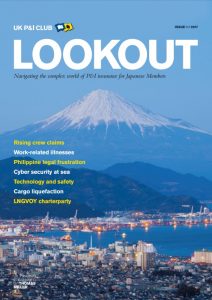Ship groundings and collisions still occur with depressing regularity, and are often attributed to errors in navigation. In the UK P&I Club’s latest LookOut, Risk Assessor David Nichol, highlights some of the contributory factors and suggests steps to ensure navigational safety.
A modern ship’s navigational bridge, with its integrated consoles, displays,state of the art technology and comfortable armchairs is very different from the equipment that was available in the 1970s. Yet accidents continue to occur despite the subsequent advances in navigational equipment design and
technology,as well as the statutory introduction of uniform minimum standards of ship management,and seafarer training and education.
- Keeping a proper lookout
Failure to maintain a suitable lookout is often cited in marine casualty reports. A proper lookout must be kept by sight and hearing, as well as by all available means appropriate to the prevailing circumstances and conditions. Similarly, the essential role of radar as an individual aid to navigation and a collision avoidance tool remains as important as ever.
Keeping a proper lookout and using all available aids to navigation will assist the officer of the watch (OOW) in acquiring an appreciation of the current and expected navigational situation, the proximity of navigational hazards and risk of collision, often referred to as situational awareness.
- The impact of technology
GPS is an invaluable aid to navigation, but its exclusive use in coastal or confined waters may not be appropriate, and is often a contributory factor in ship groundings. In these circumstances, full use of radar ranges and bearings, visual bearings and transits should also be used as a primary means of fixing the ship’s position.
The advantage of cross checking the position using these alternative methods is that it will give the OOW a better situational awareness and sense of
orientation of where the ship is located relative to the topography of the coastline and the proximity of hazard. GPS should be regarded as an aid to navigation, not a single means of navigation.
Further, ECDIS is a valuable contribution to safer navigation and assist in reducing the workload as compared to use of a paper chart. However, inadequate training, a rushed transition period over to the new system and variations in the quality of some of the equipment on the market mean that ECDIS is not always being used properly or to its full potential. An inability to properly configure the ECDIS or any lack of confidence the OOW has in the equipment is potentially dangerous.
In particular, continuously overlaying the display with radar imagery, AIS and other navigational input may clutter the display and cause the OOW difficulty in processing or assimilating information. Too much information can be as dangerous as too little, Mr. Nichol notes, and it is important for the operator to maintain the distinct functions of the chart, radar and other aids to navigation.
- Engagement and motivation of crew
When ships are engaged on regular liner services,a particular problem emerges where familiarity and low levels of stimulation may induce boredom and foster a lack of attention to detail in performing required navigational duties, which in other circumstances would not be neglected. This can erode the ability of an OOW to recognise or react to a changing situation. Complacency can also affect the master, who may fail to appreciate the need to adapt standing orders to suit the prevailing conditions or whose own judgement may be impaired by repetitive performance of tasks.
Inappropriate use of mobile phones can distract the attention of the master, pilot and watch keepers at critical moments. Playing music on the bridge or the use of iPods or similar personal devices has also been known to distract the attention of watch keepers and inhibit their ability to keep a fully effective lookout.
A fatigued or overworked watch keeper will eventually make mistakes or fall asleep on duty, with potentially serious consequences.The bridge navigational watch alarm system (BNWAS) is not there for continuously prodding an insufficiently rested watch keeper awake.
“The sea is just as hostile an environment as it ever was and the challenge of safely navigating a ship to its destination cannot yet be overcome by the application of technology alone. That still requires the presence of intelligent, well educated, motivated and properly trained people with a solid grounding in the principles of good seamanship and traditional seafaring skills,” Mr. Nichol concluded.
Explore more by reading the Club’s full issue:


































































